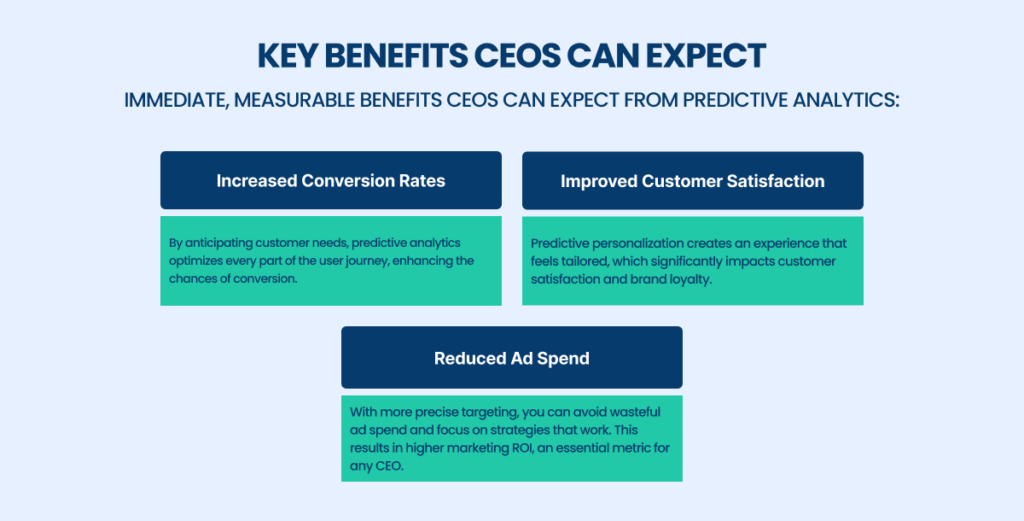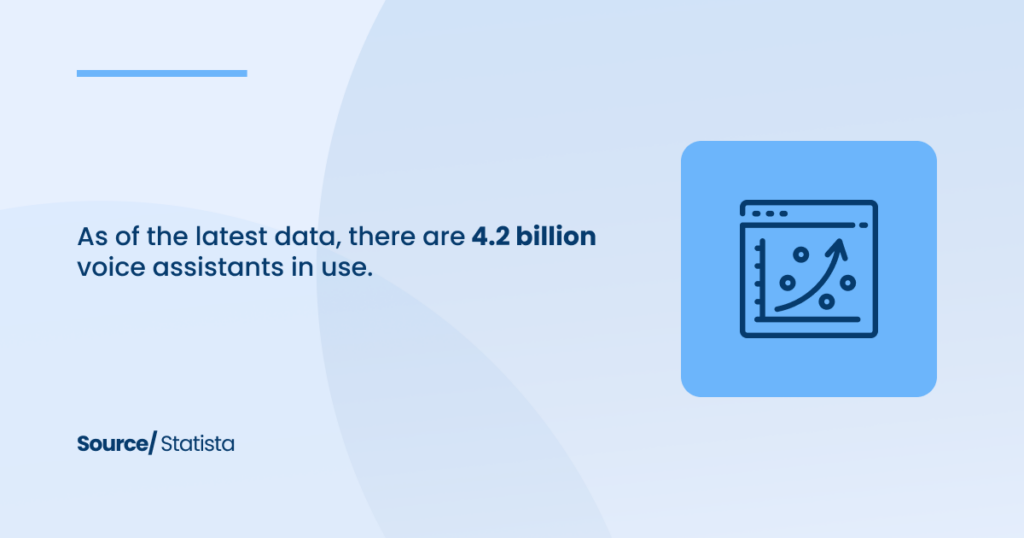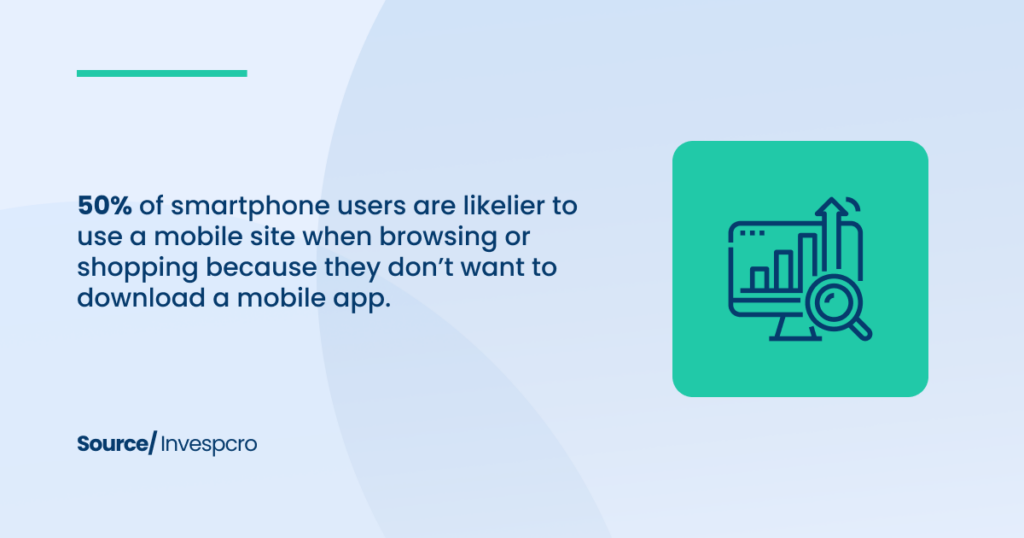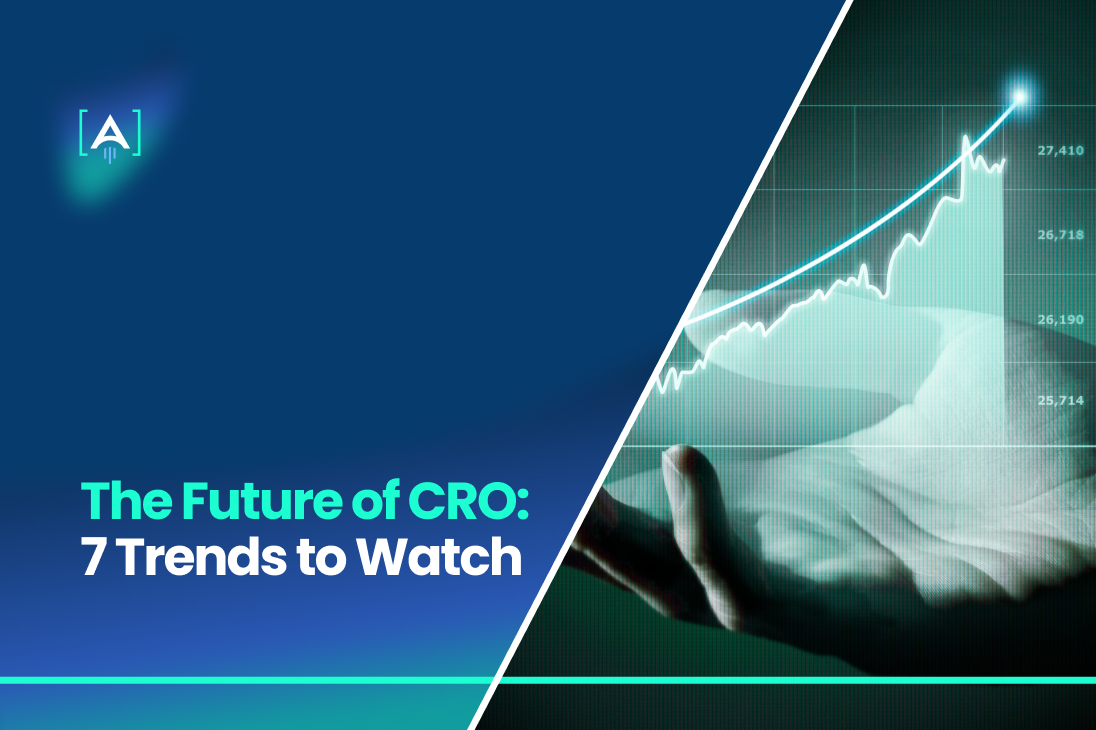The digital landscape is evolving at breakneck speed, and with it, the strategies for driving conversions.
The future of Conversion Rate Optimization (CRO) is no longer just about A/B testing and landing page tweaks.
It’s about harnessing the power of emerging technologies and adapting to consumers’ ever-changing needs.
The average conversion rate for websites is 2.35%.
Conversion rates differ by industry. If your website’s conversion rate falls between 2-3%, it’s performing reasonably well in a general sense.
However, consider that the Key Goals for Optimizing Conversion Rates are:
- Increase Sales and Leads
- Enhance User Experience
- Maximize Marketing ROI
All the above-mentioned goals are the areas where a reliable CRO Agency can make a significant impact on your success.
In this article, we’ll explore 7 key trends that will shape the future of CRO and help you stay ahead of the curve.
1. AI-Powered Personalization: The Game Changer in User Experience
Today’s consumers expect a unique, relevant experience—one that feels tailor-made just for them.
Enter AI-powered personalization, the ultimate tool for transforming user engagement by anticipating needs and adapting content in real-time.
What Exactly Is AI-Powered Personalization?
Imagine your website recognizing each visitor as soon as they arrive, showing them content that resonates based on their preferences, previous behavior, and even real-time context.
Source: Ways in which companies measure the success of using artificial intelligence (AI)-driven personalization worldwide 2023, Statista
AI-powered personalization does exactly that—it leverages vast amounts of data to adapt what each user sees, whether it’s a product recommendation, tailored message, or even personalized incentives. This approach aligns with evolving CRO trends by significantly boosting engagement and conversion rates.
For a business website, especially in ecommerce conversion rate optimization, this can mean the difference between a casual browser and a loyal customer. Think of it as the digital equivalent of having a skilled salesperson who knows precisely what your customers are looking for every time they visit.
Why AI-Powered Personalization Matters for CEOs
For CEOs focused on growth, AI personalization isn’t just a buzzword. It’s a powerful driver for business impact.
- Predicts and Meets Customer Needs in Real-Time
AI’s ability to analyze customer data—such as past interactions, time spent on specific pages, and previous purchases—enables it to create tailored experiences.
Imagine a CEO browsing a conversion rate optimization website and seeing case studies and solutions that match their industry’s needs instantly. Real-time adaptation like this is a game-changer, reducing the need for multiple clicks and encouraging direct, effective action.
- Elevates Customer Experience to Drive Loyalty
By showing content that feels curated to their needs, AI-powered personalization builds an emotional connection. As a result, customers don’t just see a site; they experience it.
A recent publication showed that personalized homepages could increase engagement by up to 300%. This heightened experience can be key for conversion rate optimization for landing pages, where engagement must be immediate to drive conversions.
- Maximizes Marketing ROI
A personalized website means CRO trends work harder for your brand.
Instead of casting a wide net, you’re delivering refined content that aligns perfectly with each user’s intent.
This approach minimizes wasted clicks and boosts overall marketing ROI. A CEO looking to allocate resources more efficiently can view AI personalization as a path to reduced ad spend and increased conversions.
2. Predictive Analytics: See What’s Next Before It Happens
Predictive analytics is more than a trend; it’s the next-level strategy for CEOs to anticipate and meet customer needs.
By analyzing historical data, predictive analytics uses patterns to forecast what customers are likely to do next. Imagine knowing how visitors will behave before they even interact with your website.
This technology enables you to optimize conversion rates with remarkable precision, aligning your strategies with where your customers are headed.
What Does Predictive Analytics Mean for CEOs?
For CEOs, predictive analytics is a tool that doesn’t just answer “what happened” but rather “what’s next.” It helps leaders like you see changes coming and make proactive adjustments.
Rather than reacting to metrics after the fact, you get real-time insights to adjust marketing efforts, conversion paths, and customer engagement before potential issues arise. Think of it as a crystal ball for your business strategy.
Predictive analytics taps into one of the most promising CRO trends: data-backed decision-making. When you have a roadmap based on customer behaviors and preferences, your strategy becomes smoother and less speculative.
For CEOs focused on growth, this means increased ROI, reduced marketing spend waste, and more accurate, efficient resource allocation.
How Predictive Analytics Enhances CRO (Conversion Rate Optimization)
The true power of predictive analytics lies in its ability to drive conversion rate optimization/ CRO trends for better business results.
With predictive insights, you can optimize the user journey, adjust your messaging, and make sure the most relevant content reaches the right audience at precisely the right time.
- Identifies High-Value Leads
Predictive analytics identifies leads that are more likely to convert by analyzing patterns and customer segments. Rather than spending time and money on broad, generalized campaigns, you can zero in on high-quality leads that bring greater value to your business.
- Personalizes the User Journey
By predicting user needs, you can tailor the customer experience from the start. For example, if predictive data shows that certain segments respond better to specific messaging, calls to action (CTAs), or offers, you can implement these elements dynamically. This approach is particularly powerful in conversion rate optimization for landing pages, where personalized content can be the difference between a bounce and a conversion.
- Boosts Marketing Efficiency
Predictive analytics doesn’t just improve outcomes; it also reduces costs.
Knowing what marketing efforts will yield the best results means you can allocate resources more wisely.
- Prevents Churn Before It Happens
Predictive analytics can flag potential churn risks by analyzing customer behavior.
For example, if users frequently abandon carts at a certain stage, predictive data can help identify why. With this insight, you can address common issues that lead to churn, creating a more seamless experience that encourages users to complete their journey on your site.

3. Talk, Don’t Type: How Voice Search is Reshaping Online Queries
As voice search becomes a daily habit for millions, businesses must now adapt to a world where customers expect instant, conversational answers.
Imagine your customer asking their device for a quick solution—and your brand pops up with exactly what they need. This is why optimizing for voice search is quickly becoming one of the most important CRO trends for CEOs looking to stay relevant and capture new customer segments.
Why Voice Search Optimization Matters for CEOs
For CEOs, voice search is a game-changer, directly affecting how customers find your brand. By optimizing for voice, you create new touchpoints with potential customers, offering immediate answers that fit seamlessly into their day-to-day routines.
Voice search is inherently conversational, making it essential for CEOs to tailor their digital presence to meet this rising demand.

This isn’t just about SEO—it’s about meeting customer needs exactly when they ask for it.
Why should you take voice search optimization seriously?
- Growing Usage: According to recent data, nearly 58% of consumers have used voice search to find local business information. This trend is only expected to grow, meaning more customers will search by asking questions rather than typing keywords.
- Higher Engagement: Voice search often translates into quicker actions. Customers who get answers fast are more likely to engage further, whether that’s visiting your website, checking out a product, or making a purchase.
How to Optimize for Voice Search
To rank well for voice queries, your conversion rate optimization services need to focus on natural, conversational language:
- Use Natural Language and Long-Tail Keywords
Voice searches typically consist of longer, more conversational phrases—think “What’s the best eCommerce software for small businesses?” rather than “eCommerce software.” Use this insight to optimize for question-based keywords that align with what your audience is likely to ask.
- Optimize for Featured Snippets
Google often pulls voice search answers from featured snippets. Aim to answer common questions directly on your pages, using concise and informative language. This can boost your visibility and increase your chance of being the chosen answer for voice search results.
- Focus on Local SEO
Many voice searches are location-based, so optimizing for local keywords can enhance your reach. Ensure your business address, contact info, and hours are up-to-date and integrate local keywords wherever relevant.
- Answer Common Questions in Your Content
Customers often ask questions like “How can I optimize my website for more conversions?” Think about these types of inquiries and incorporate them into your FAQs, product pages, or even blog content.
By creating content that mirrors real-life questions, you increase your chances of appearing in voice search results.
4. The Rise of Visual and Interactive Content: Engaging Users Beyond Text
In today’s fast-paced digital landscape, visual and interactive content is king.
From images to infographics, quizzes, and videos, these elements grab user attention faster than text alone.
Think of it as adding color to your message—it stands out, captures interest, and makes your message memorable.
As consumers crave more engaging experiences, businesses that prioritize visual and interactive content will see higher engagement, lower bounce rates, and, most importantly, increased conversions.
Why Visual Content is Essential for CEOs
For CEOs, the shift towards visuals is an opportunity to connect with audiences more deeply.
Source: HubSpot
Text alone no longer holds the same weight; consumers want a richer experience that helps them visualize, interact with, and understand your offerings better.
Visual and interactive elements are ideal for quickly conveying complex ideas, simplifying decision-making, and enhancing your brand’s appeal.
- Higher Engagement Rates: Content with visuals gets 94% more views than plain text content. That’s a stat CEOs can’t afford to ignore.
- Increased Information Retention: Studies show that people remember 80% of what they see, compared to only 20% of what they read. Visuals are invaluable for CEOs looking to boost brand recall.
- Enhanced Brand Perception: Visuals don’t just inform. They evoke feelings and create perceptions. This makes visual content a powerful tool in shaping how customers feel about your brand.
Types of Visual Content to Include for Better Conversions
- Infographics and Data Visualizations
Infographics break down complex data into digestible pieces, helping users understand key points quickly. Use them to illustrate stats, processes, or benefits, making it easy for visitors to absorb information.
- Videos and Animations
Videos are one of the most engaging forms of content. Use explainer videos to showcase how a product works, customer testimonials to build trust, or product demos to highlight key features. According to HubSpot, 54% of consumers want to see more video content from brands they support.
- Interactive Content Like Quizzes and Polls
Interactive elements keep users engaged and provide valuable insights into customer preferences. For example, a quiz on “Which of our solutions fits your needs best?” helps users explore your offerings and guides them toward the right product. Quizzes can increase engagement and encourage customers to stay on your site longer.
- Live Demos and Interactive Product Tours
Especially for eCommerce conversion rate optimization, interactive product tours or virtual try-ons can make all the difference. They allow users to engage with products in a hands-on way, creating a more immersive experience that mimics an in-store visit.
5. Enhanced Mobile CRO: Optimizing for On-the-Go Conversions
With mobile usage continuing to dominate digital interactions, optimizing for on-the-go conversions is now essential. Imagine your customers checking their phones during a busy day, maybe looking for a quick solution to a problem.
In those moments, every second matters. If your mobile site doesn’t deliver an intuitive, fast, and seamless experience, you risk losing their attention to a competitor.

For CEOs, understanding the weight mobile optimization carries in today’s world is crucial. It’s no longer enough for your website to look good on a desktop; it must perform smoothly on mobile.
Mobile optimization in conversion rate optimization/ CRO trends is about making your site intuitive, with fast-loading pages, easy navigation, and clear calls to action—all tailored to meet the demands of mobile browsing. This is why many companies now partner with specialized conversion rate optimization agencies to develop mobile-first strategies.
They know that mobile traffic often outpaces desktop, especially for e-commerce businesses, and that high-performance mobile sites lead to significantly higher conversions.
6. Data Privacy and Transparency: Building Trust Through Security
As digital interactions expand, data privacy has become a focal point, especially with rising user concerns and regulatory demands. For CEOs, safeguarding customer data and maintaining transparency are non-negotiable.
When users trust that their data is safe, they are far more likely to engage and convert, underscoring the role of privacy in conversion rate optimization/ CRO trends.
In a world where digital transactions are second nature, customers increasingly expect that their data is being handled responsibly.
Transparent data practices have become synonymous with trust, and a lack of transparency can quickly erode confidence. Trust-building goes beyond securing data; it includes clearly explaining how data is collected, stored, and used.
Many CEOs underestimate how much a simple privacy statement, crafted in clear and accessible language, can impact conversions. When customers feel their privacy is prioritized, they’re more likely to take action on your website, from signing up for newsletters to completing purchases.
7. Continuous Testing & Optimization: CRO as an Ongoing Process
When it comes to conversion rate optimization (CRO), success isn’t a one-time goal but an ongoing journey. As digital landscapes and consumer behavior shift, the methods that worked last year, last quarter, or even last month may not be as effective today.
For CEOs, this means that keeping conversion rates high requires constant testing and refinement. CRO isn’t about setting and forgetting—it’s about adapting to create the most seamless, engaging experience for users.
Imagine CRO as a perpetual feedback loop.
The Power of A/B Testing: Experimenting for Clarity
Think of A/B testing as a powerful method to understand what resonates best with your audience.
With this approach, you can test two variations of the same page element—such as a headline or call-to-action (CTA)—to see which performs better.
For example, let’s say you’re running a landing page with two versions of a CTA. You notice that “Get Started Today” outperforms “Sign Up Now.” That’s useful insight because, through A/B testing, you’ve learned what kind of language spurs action from your audience.
Multivariate Testing: Digging Deeper
While A/B testing is valuable, it focuses on changing one variable at a time.
Multivariate testing, however, allows you to test multiple elements at once.
For instance, you can test different combinations of headlines, images, and CTA placements to see which combination creates the best user experience. This testing is like A/B on steroids—it’s thorough, but it requires more traffic to yield reliable results.
Self-Assessment Quiz: Which CRO Trend Should You Focus On?
Take this quick quiz to find out which CRO (Conversion Rate Optimization) trend can best support your business goals.
1. What is your primary business goal for the next 12 months?
- A) Increase customer engagement and loyalty.
- B) Predict and meet customer needs proactively.
- C) Capture more conversions from mobile users.
- D) Boost visibility on voice search platforms.
2. What type of product or service does your business offer?
- A) A diverse product range that could benefit from personalized recommendations.
- B) Solutions or services with high repeat usage, where predicting user behavior is key.
- C) A high volume of mobile traffic and on-the-go users.
- D) Local services or businesses where users may look up information using voice commands.
3. How does your website currently handle user data and insights?
- A) It collects basic demographic data, but I’d like to make it more personalized.
- B) It gathers data, but I want to use it to anticipate user behavior better.
- C) It tracks mobile engagement, but I need to optimize the experience further.
- D) It doesn’t handle voice search well yet, and I want to improve that.
4. Which resource describes your team’s capabilities best?
- A) We have a team ready to handle AI-powered personalization tools.
- B) Our team is data-driven and skilled in analytics.
- C) We have mobile development resources to refine our mobile CRO.
- D) We’re equipped for technical adjustments and want to explore voice search optimization.
5. What’s the biggest pain point on your site currently?
- A) Visitors aren’t engaging as much as I’d like.
- B) I lack insights into future customer actions.
- C) My mobile traffic has a high bounce rate.
- D) I’m not getting visibility on voice-based searches.
6. How important is staying competitive with emerging technology to your business?
- A) Extremely important – we aim to lead in customer experience.
- B) High – I want to anticipate trends and be proactive.
- C) Important, particularly for optimizing mobile experiences.
- D) Important – voice search seems to be the next big thing, and I don’t want to miss out.
7. What would success look like for you after implementing a new CRO trend?
- A) Higher customer engagement and a personalized experience.
- B) Anticipating user needs and boosting conversion through prediction.
- C) A significant increase in mobile conversions.
- D) Improved visibility on voice search, leading to more leads or visits.
Wrap-up: From Guessing to Knowing
As the digital landscape continues to evolve, so too must our approach to conversion rate optimization.
Remember, CRO is an ongoing process, not a one-time fix. By continuously testing, analyzing, and refining your strategies, you can achieve sustainable growth and maximize your return on investment.
If you have already made the self-assessment, you definitely know what you need. [A] Growth Agency is ready to assist.
We specialize in turning entrepreneurial dreams into reality with effective, tailored growth strategies. Also, we believe in the power of data to inform and drive every strategy, ensuring our actions are as effective as they are innovative.
If this is your accepted working approach, then you know what to do.

